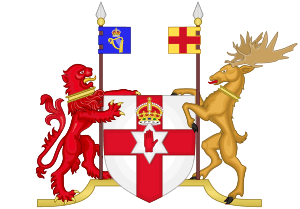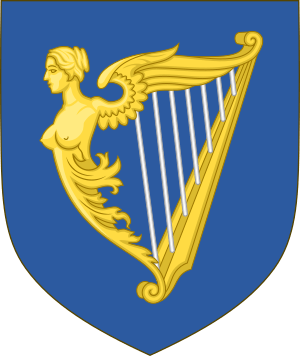Coat of arms of Northern Ireland facts for kids
Quick facts for kids Coat of arms of the Government of Northern Ireland |
|
|---|---|
 |
|
| Versions | |

The banner of arms, which served as the territory's flag ('Ulster banner') 1953–1972
|
|
| Armiger | Government of Northern Ireland (dissolved in 1972) |
| Adopted | 1924 |
| Blazon | Argent a cross gules, overall on a six pointed star of the field ensigned by an Imperial crown proper a dexter hand couped at the wrist of the second. |
| Supporters | Dexter a lion gules armed langued and collared or, supporting a flagstaff proper, therefrom flowing to the sinister a banner azure, charged with a harp or, stringed argent, surmounted by an imperial crown proper; Sinister an Irish elk proper, collared or, supporting a like staff, therefrom flowing to the dexter a banner or charged with a cross gules. |
| Compartment | On a grassy mount two flax plants each with three flowers on stems proper. |
| Use | The Parliament of Northern Ireland was prorogued in 1972. The arms have not been used officially since then. |
The coat of arms of the Government of Northern Ireland was a special symbol. It was given to the government of Northern Ireland in 1924. A coat of arms is like a unique picture or emblem. It represents a country, a family, or an organization. This one showed important things about Northern Ireland.
Contents
What is a Coat of Arms?
A coat of arms is a design that acts like a special badge. It often has a shield with symbols on it. These symbols tell a story about the group it represents. It might also include animals or other figures. These figures are called "supporters."
Designing the Coat of Arms
The coat of arms was created by Sir Nevile Wilkinson. He was an expert in coats of arms. He worked at Dublin Castle in 1923. In 1924, he talked with officials from Northern Ireland. They met in London to discuss the design.
His helper, Thomas Ulick Sadleir, finished the design. The Northern Irish government approved it in April 1924. King George V officially signed the approval. This happened on August 2, 1924.
The Main Shield Design
The main part of the coat of arms is the shield. Here is what it looks like:
- It has a silver background.
- There is a red cross on it.
- On top of the cross, there is a six-pointed silver star.
- A special crown sits on the star.
- A red hand is placed on the star. This hand is cut off at the wrist.
This design was officially written down in Dublin. It was recorded in the Register of Arms.
The Supporters and What They Mean
In 1925, two animals were added to the design. These animals are called "supporters." They stand on either side of the shield.
- One supporter is a red lion. A "rampant" lion stands on its back legs. This lion is like the one on the Royal Banner of Scotland. It represents the Ulster Scots.
- The other supporter is an Irish elk. This large deer represents the "native element" of Northern Ireland.
Both animals hold flags.
- The lion holds a blue flag with a golden Irish harp on it. The harp has silver strings. A crown is above the harp.
- The Irish elk holds a golden flag with a red cross on it. This cross is similar to the one on the shield.
The Base of the Arms
In 1971, more details were added to the design. A "compartment" was added. This is the ground or base where the supporters stand.
- It is a green grassy hill.
- On the hill, there are two flax plants. Each plant has three flowers. Flax is a plant grown for its fibers.
Why This Coat of Arms is Historical
The government body that used this coat of arms no longer exists. It was dissolved in 1972. Because of this, the coat of arms is now considered historical. It cannot be used officially today. A new government would need to be granted a new coat of arms.
The Northern Ireland Executive is the current government. It does not use a coat of arms.
The Flag of Northern Ireland
The former flag of Northern Ireland came from this coat of arms. It was simply the shield part of the arms. Supporters are never shown on a flag. They are not part of the main arms. They just support the shield.
This former flag is still used sometimes. You might see it at some sports events. However, its use today can be seen differently by people in Northern Ireland.
The Celtic harp is another important symbol. It represents Ireland in the Royal coat of arms of the United Kingdom. This means it indirectly represents Northern Ireland too.
See also
 In Spanish: Escudo de Irlanda del Norte para niños
In Spanish: Escudo de Irlanda del Norte para niños


